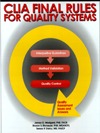CLIA Final Rule
Part IV: The New Method Validation Regulations
Final5 CLIA Rule. Part IV:
The New Method Validation Regulations
Dr. Sharon S. Ehrmeyer provides more analysis of the new CLIA Final Rule. Now that there are only 2 categories of tests - waived and non-waived - what experiments must be performed on non-waived tests? JCAHO and CAP requirements are also discussed. (preview)
- General Requirements for Quality Control of Laboratory Systems
- MV recommendations depend on test complexity
- JCAHO standards for method validation
- Quality vs. Compliance
- References
The regulations disseminated on February 28, 1992 for laboratories to comply with the Clinical Laboratory Improvement Amendments of 1988 (CLIA '88) included specific quality control (QC) regulations for laboratories performing moderate and high complexity testing [1]. These regulations also contained specific method validation requirements for modified moderate and high complexity tests and tests developed in-house. Test sites performing unmodified, FDA approved, moderate complexity testing could accept the manufacturer's performance specifications and were not required to perform any method validation. On January 24, 2003, the Centers of Medicare and Medicaid Services (CMS) issued the final CLIA rules [2]. These rules bring ALL non-waived (moderate and high complexity) testing under uniform QC requirements, including validation of methods.
While CLIA sets the minimum testing requirements, testing sites can and do choose to meet the requirements of accreditation organizations with CLIA-deemed status such as the Joint Commission for Accreditation of Healthcare Organizations (JCAHO) [3], the College of American Pathologists (CAP) [4], and the Commission on Office Laboratory Accreditation (COLA)[5]. There are also state health laboratory organizations in Washington and New York, which are approved by the government (have exempt status) and impose specific requirements. And, it is always important to keep in mind those practices that would be expected as part of professional responsibility and good laboratory practice.
General requirements for quality control of laboratory tests
CLIA provides a broad framework of quality control based on a quality systems approach that follows the route of a specimen through the laboratory. Section §493.1200 of Subpart K, Quality Systems for Non-waived Testing, begins with the statement:
"Each laboratory…must establish and follow written policies and procedures that implement and monitor quality systems for all phases of the total testing process …"
Section §493.1250, Analytic Systems, states:
"…The laboratory must monitor and evaluate the overall quality of the analytic systems and correct identified problems…
Subpart K under the analytic systems section defines a broad set of standards for quality systems, which include sections on each of the following:
- Procedure manual (§493.1251)
- Test systems, equipment, instruments, reagents, materials, and supplies (§493.1252)
- Establishment and verification of method performance specifications (§493.1253)
- Equipment maintenance and function checks (§493.1254)
- Calibration and calibration verification procedures (§493.1255)
- Control procedures (§493.1256)
- Specialty and subspecialty requirements (§493.1261-1278)
- Comparison of test results (§493.1281)
- Corrective actions (§493.1282)
- Test records (§493.1283)
- Analytic systems assessment (§493.1289)
The section on the "establishment and verification of method performance specifications" provides the recommendations for method validation studies.
 Want to read the rest of this article?
Want to read the rest of this article?
We invite you to purchase the CLIA Final Rules manual, available through the online store. You can download the Table of Contents and a preview chapter for free.
